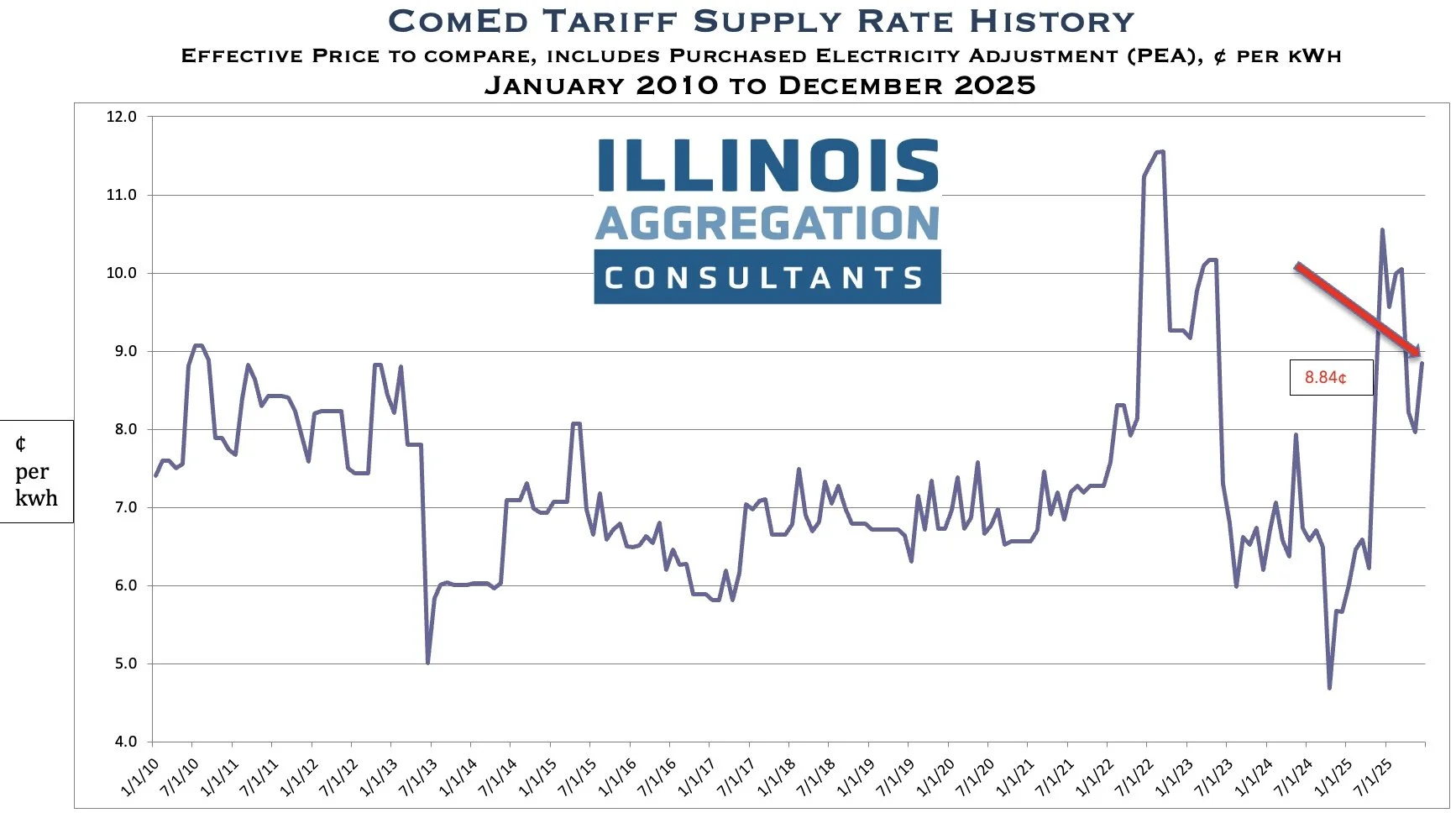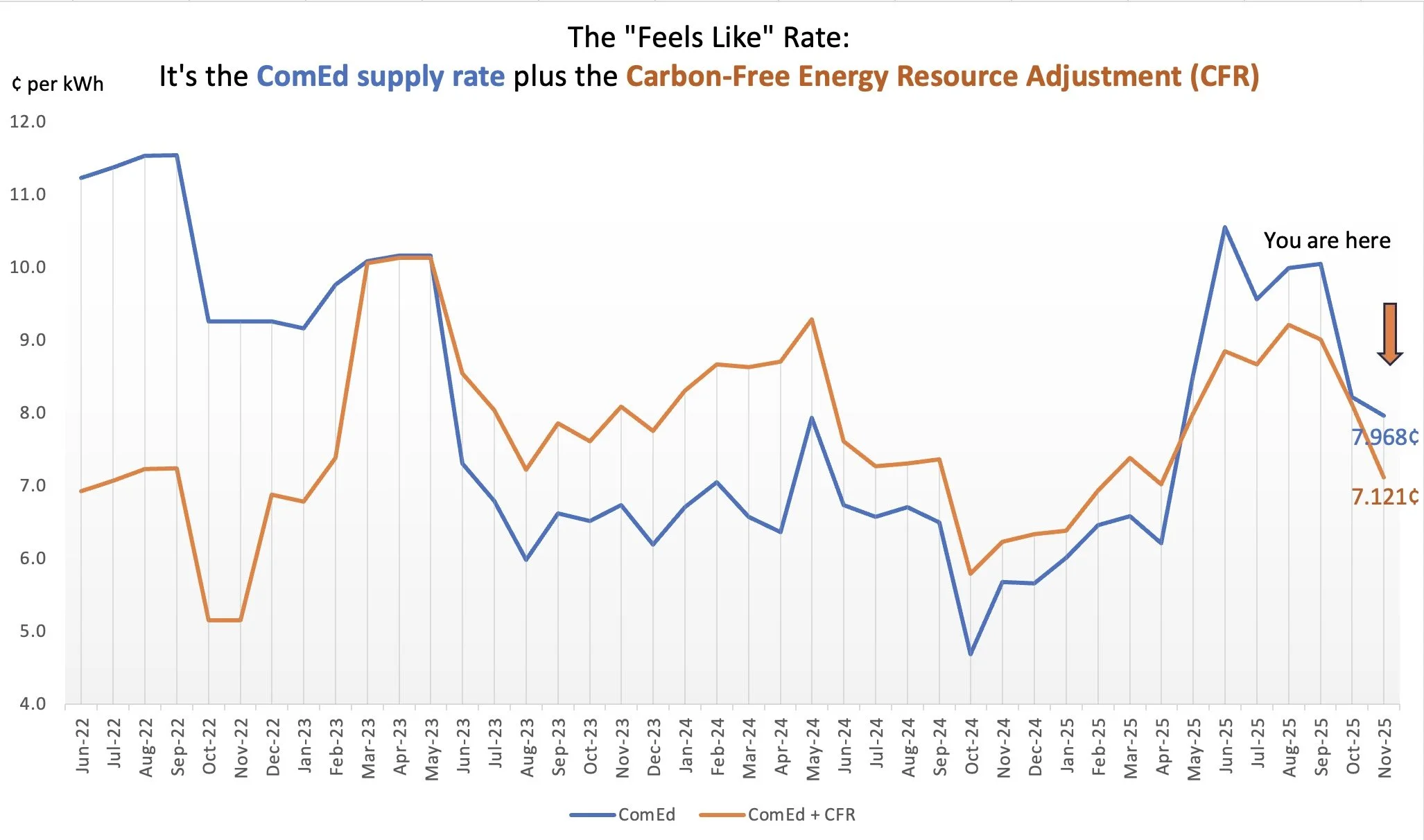
The December ComEd supply rate is 8.84¢ per kWh
The effective ComEd residential and small commercial retail supply rate rose from 7.968¢ in November to 8.84¢ in December 2025. It’s comprised of the non-summer base rate of 9.689¢ less the December Purchased Electricity Adjustment (PEA)* credit of 0.849¢.
What’s driving the increase from a year ago? (The December 2024 rate was 5.66¢.)
A 2024 capacity price auction for the PJM power grid which covers 13 states including ComEd territory, resulted in an 800% increase in capacity charges. These charges, a small component of supply costs, exist to ensure sufficient power is available to meet demand. Analysts generally believe the spike to be driven by:
Surging Demand: Increased electricity use by data centers and AI applications.
Insufficient Generation: Scheduled closures of fossil fuel plants, mandated by regulatory bodies, have not been fully offset by new renewable energy development, which faces delays.
Residents enrolled in a ComEd Price Match Electric Aggregation program will be charged these same rates.
To note: ComEd passes supply charges directly to customers with no markup. The company’s revenue is derived from delivery charges.
How does the supply rate appear on my ComEd bill? Observe the second page under “Supply” where the rate is broken into three line items. Note the first two charges equal the base rate of 9.689¢ and the third is the monthly variable (PEA):
Electricity Supply Charge - $0.07873
Transmission Services Charge - $0.01816
Purchased Electricity Adjustment - listed as a dollar amount which is determined by kWh x PEA. For example, if your consumption is 750 kWh and the PEA credit is 0.849¢, your total PEA credit is $6.37.
The impact of Rider CFRA: Beginning in 2022, in addition to tracking supply costs, it became relevant to track the Carbon-Free Energy Resource Adjustment (CFRA) enacted by CEJA. For June 2025, it’s a credit to ratepayers of 1.703¢ per kWh, which will somewhat temper the spike in the supply rate. Because that can have a profound impact in effect, offsetting the supply rate, we track it for you on the “Feels Like” rate chart. This charge (or credit) is noted in the Taxes & Fees portion of your bill.
The Carbon-Free Energy Resource Adjustment: CEJA—Public Act 102-0662—signed into law by Governor Pritzker in September 2021 established a plan to preserve nuclear generation facilities from closure. The Carbon Mitigation Adjustment is to ensure preservation of existing carbon-free, nuclear generation facilities which might otherwise retire. The concept is to enable carbon-free resources to remain in place until Illinois is able to develop other forms of clean energy.
How to save on power costs? In addition to basic thermostat re-sets, discover energy savings tips here.
You have more questions? Just ask.
*PEA: In addition to the Price To Compare (i.e., the default ComEd base rate), a monthly variable portion is included: the PEA is a additional credit or charge that is the difference between the revenues from the monthly ComEd PTC and the actual cost of electricity supplied to ComEd customers. This charge or credit, ensures ComEd customers pay no more or less than ComEd’s actual cost of purchased electricity. The Illinois Commerce Commission states, “The future PEA values would be expected to average near zero for the planning year…”
Data sources:
Illinois Commerce Commission Chief Clerk
Illinois.gov press releases
Commonwealth Edison Company tariff filings
To borrow meteorologists’ verbiage, the “Feels Like” rate impacts the total electric bill charge. Currently, it’s a credit, softening the recent sharp increase in the supply rate
For more detail about the ComEd Price to Compare, visit www.PlugInIllinois.org


